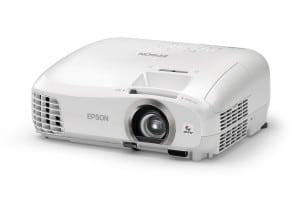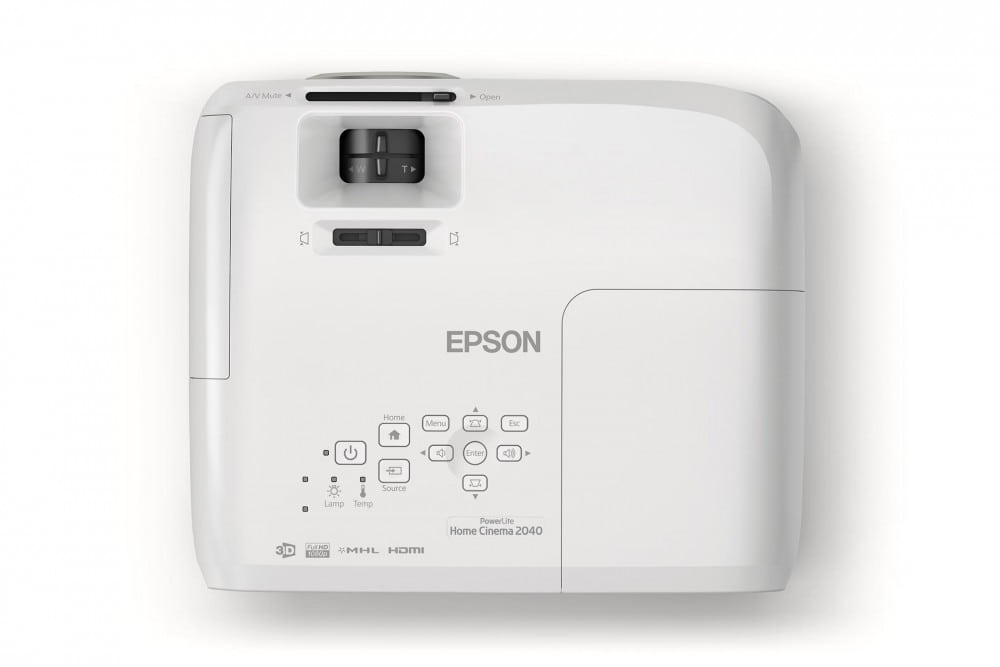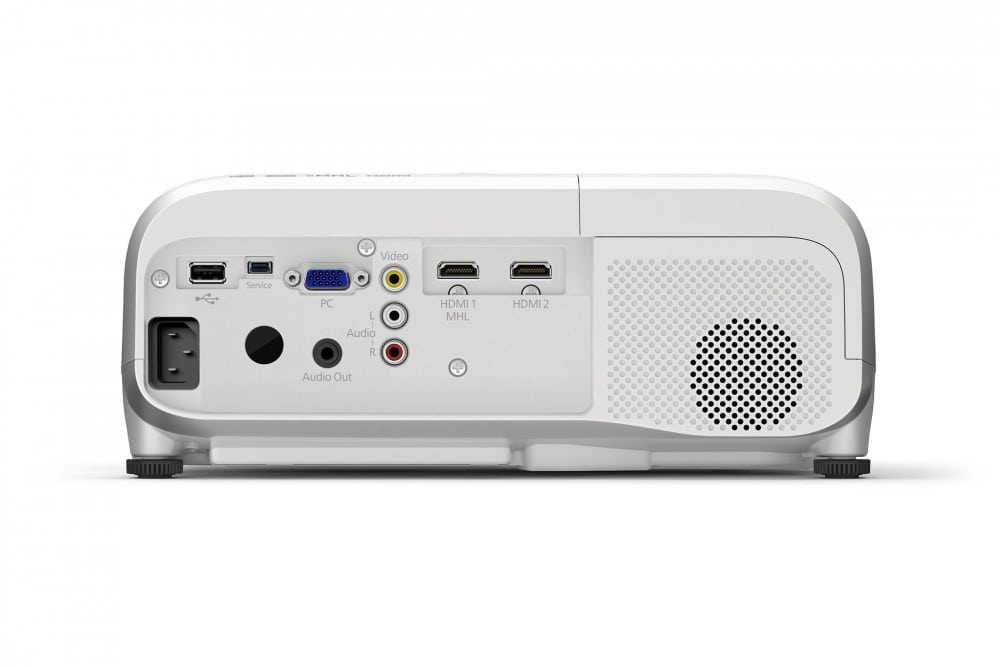HOME CINEMA 2040 AND 2045 PROJECTORS - HARDWARE TOUR: Overview, Lens, Control Panel, Inputs and Connectors
HC2040 and HC2045 Hardware Overview
The Home Cinema 2040 and 2045 are smallish projectors. With a footprint slightly less than 9.7x11.7 inches that makes the footprint a little bit larger than a standard sheet of paper (8.5x11). These projectors weigh in at just under six and a half pounds, making them nicely portable. For perspective that's about a pound more than a six pack of soda or beer in the usual 12 oz cans. We all know how portable a six pack is! The control panel is located on the top of the projector, while all the inputs and other connectors are on the rear.

The front of the Epson Home Cinema 2040 projector.
The front of these projectors starts with a manual zoom lens mounted off center. The zoom ratio is 1.22:1 providing a modest amount of placement flexibility. 1.1:1 to 1.3:1 is what's found on most low cost projectors.
Just above the lens, on the top, is a slide that when closed blanks the screen, and protects the lens. Below the lens, toward the center is a button for the front drop down, adjustable foot. The bottom back of the projector has two more small feet.
Also found on the front is one of the IR sensors for the small remote control (it's to the right of the lens, and below. On the far left is the exhaust vent. When running at full power, you don't want to be sitting 1-2 feet in front of the projector and a foot to the right - or you will feel the heat. Most projectors these days vent out to the front and sides, so this is typical.
In the image above, you can see a filter area on the right side. A quick release lets you access. You won't need to change that filter probably for a couple / few years, unless you live in a very dusty dirty place. The projector will tell you when it's time to change it out.
Back to the lens. On the top of the projector, just behind the lens are two recessed dials. The one closest to the front is the focus, the one right behind it, the zoom control. Just behind both of those is a slider for quick keystone correction of the image (getting it properly rectangular if your setup is a little "funky").
Control Panel

Top view of Epson HC2040/HC2045 projectors, including the control panel, lens controls, and keystone correction
Above you can see the full control panel (click for a larger image, if need be). From the far left are some indicator lights (LEDs) for Power, Temp, and Lamp.
The left most button is Power. Press once to turn on, twice to power down. It takes the projector less than 10 seconds to put a picture up on the screen, but accurate color takes a little longer. By the time the projector is on a full minute, the color is pretty close to stable, and looking good. The next button says "HOME," and that's a new button on Epson projectors. Pressing it brings up a general, and more graphical Overview menu that lets you jump directly to one of several popular menu items. A nice addition, but hardly a "to die for" feature.
Just below the Home, (that is, closer to the back of the projector), is the Source button. Then, moving to the right, we find the whole navigation controls area. For that section, you'll find the Menu button on the left (just to the right of the Home button). Then comes the four navigation arrow buttons (up/down/left/right) in a diamond configuration. To the right of the Menu and Up arrow, is the Esc(ape) button which steps you back a level when navigating the menus. That's about it, except that the left and right arrow buttons double as your down and up volume controls when you aren't in the menus, and the up and down arrows double for keystone correction. (Both sets of features can be controlled from inside the menus as well.)
All considered, the control panel is pretty straightforward. I note that these projectors lack the Help button found on many previous Epson projectors. That brought up some interactive help - question based - and could take you to the correct controls to adjust. That was always a nice touch, but Epson never had more than a half dozen or so questions in that help area, so I suspect it won't be really missed by anyone. Those answers would be found in the manual regardless.
HC2040 and HC2045 Inputs and Connectors

Back of Epson Home Cinema 2040 showing all the inputs including HDMI with MHL
As is usual, we'll next run through all the connectors on the projector, starting from he left side.
Well, first (or last), you can't miss the power receptacle. Just above that and slightly to the right is the first of two USBs. This one is general purpose, such as bringing in photos via a USB thumb stick (or with an adapter) an SD card from your camera. The smaller USB next to it is simply a service port, so not something you, as consumer would use, unless Epson came out with some sort of user upgrade program.
Next over is a standard HD15 analog computer input, for connecting to your typical, but not HDMI capable laptop or desktop. That same connector also serves up Component Video, although you'll need a small adapter. I wouldn't worry about either as today most devices now have HDMI. Good to have those there, should you need it though (such as if you have a 4 or 5 year old computer).
Next up are three RCA jacks lined up vertically. That's your basic video input and a pair of stereo audio inputs. That's composite video, far lower resolution than the projector is capable of. You might use it with an old VHS tape player or DVD player, although most DVD players now have HDMI. It would work with that really old camcorder of yours as well, but we're talking way below HD resolution.
That brings us to the two HDMI inputs. The one that's to your left when looking at the back is HDMI 1, and that's the one that will accept MHL devices such as streaming sticks, or a direct connect to a tablet that supports MHL. MHL could be used for lots of things. I never checked but I wouldn't be surprised if GoPro had a device using MHL to plug in, that would let you view feeds directly from your GoPro camera. As I mentioned, MHL is becoming pretty standard stuff on new projectors in the under $2000 price range.
The only things I haven't yet mentioned, are next to the power receptacle. There's the rear IR sensor for the remote control, and next to it, is the Audio Out I've previously mentioned. The Audio Out is a standard stereo mini style connector.
That folks, covers all the inputs and connectors.




